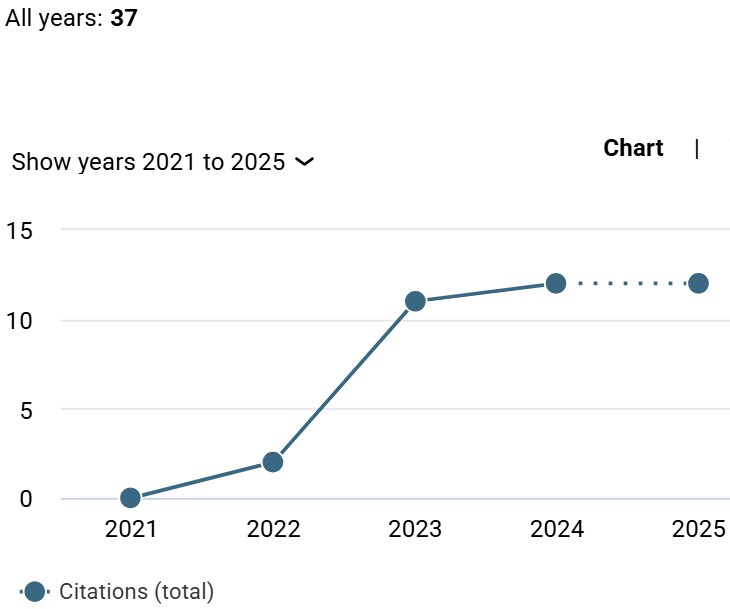Chemical Composition of Fresh and Dried Penja Fish (Sicyopterus pugnans)
Abstract
Sicyopterus pugnans, commonly known as Penja fish, is a freshwater endemic species with a savory taste and distinctive aroma, making it a popular food commodity in West Sulawesi, Indonesia. This fish is commonly consumed either fresh or dried. This study aimed to determine and compare the nutritional composition of Penja fish in fresh and dried forms. The study employed an experimental method using proximate analysis, which included measurements of protein, fat, ash, and moisture content. The samples consisted of fresh Sicyopterus pugnans and traditionally processed dried fish. The results showed that fresh Penja fish contained 17.98% protein, 3.62% fat, 1.55% ash, and 71.87% moisture. In contrast, dried Penja fish exhibited increased nutrient concentrations with 63.80% protein, 12.70% fat, 7.88% ash, and reduced moisture content of 12.54%. The study concludes that Penja fish is highly nutritious, particularly in protein content, and has significant potential to be developed as a high-nutrient local food source.
References
Badan Standardisasi Nasional. (2016). SNI 8273:2016 Ikan asin kering. Badan Standardisasi Nasional.
Bulla, M. K., Simionato, J. I., Matsushita, M., Coró, F. A. G., Shimokomaki, M., Visentainer, J. V., & de Souza, N. E. (2011). Proximate composition and fatty acid profile of raw and roasted salt-dried sardines (Sardinella brasiliensis). Food and Nutrition Sciences, 2(5), 440–443. https://doi.org/10.4236/fns.2011.25062
Damongilala, L. J. (2021). Kandungan gizi pangan ikani. Patma Media Grafindo; Bandung.
Direktorat Jenderal Kementerian Kelautan dan Perikanan. (2019). Katalog SNI produk perikanan nonpangan (SNI Produk Non Pangan, hlm. 37).
Fallah, A. A., Nematollahi, A., & Saei-Dehkordi, S. S. (2013). Proximate composition and fatty acid profile of edible tissues of Capoeta damascina (Valenciennes, 1842) reared in freshwater and brackish water. Journal of Food Composition and Analysis, 32(2), 150–154. https://doi.org/10.1016/j.jfca.2013.09.004
Fajriana, H., & Ma’rifatullah, F. R. (2019). Kandungan Gizi Tepung Ikan Penja pada Berbagai Metode Pengeringan. Jurnal Nutrisia, 21(2), 61–66. https://doi.org/10.29238/jnutri.v21i2.133
Heuzé, V., Tran, G., & Kaushik, S. (2015, May 11). Fish meal. Feedipedia, a programme by INRAE, CIRAD, AFZ and FAO. https://www.feedipedia.org/node/208
Jayadi, Y. I., & Rahman, A. (2018). Analisis kandungan gizi makro pada ikan duo (penja) hitam dan putih sebagai pangan lokal Kota Palu. GHIDZA: Jurnal Gizi dan Kesehatan, 2(1), 31–38.
Lastri, D. R., & Putra, Y. P. (2020). Karakterisasi mutu fisik dan makronutrisi fillet ikan jebung (Abalistes stellaris). Manfish Journal, 1(1), 15–20.
Mutmainnah, N., Asyiah, I. N., & Novenda, I. L. (2021). Pemanfaatan alat tangkap ikan tradisional oleh nelayan Pulau Bawean Kabupaten Gresik. Jurnal Perikanan Tropis, 8(1), 23–34. https://doi.org/10.35308/jpt.v8i1.1923
Nielsen, S. S. (2010). Food analysis (4th ed.). Springer. https://doi.org/10.1007/978-1-4419-1478-1
Ramlah, R., Soekendarsi, E., Hasyim, Z., & Hassan, M. S. (2016). Perbandingan kandungan gizi ikan nila Oreochromis niloticus asal danau mawang Kabupaten Gowa dan danau Universitas Hasanuddin Kota Makassar. BIOMA: Jurnal Biologi Makassar, 1(1), 39–46. https://doi.org/10.20956/bioma.v1i1.1098
Shearer, K. D. (1994). Factors affecting the proximate composition of cultured fishes with emphasis on salmonids. Aquaculture, 119(1), 63–88. https://doi.org/10.1016/0044-8486(94)90444-8
Taşbozan, O., & Gökçe, M. A. (2017). Fatty acids in fish. In A. Catala (Eds.), Fatty acids (pp. 143-159). InTech. https://doi.org/10.5772/68048
Tzompa-Sosa, D. A., Yi, L., van Valenberg, H. J. F., van Boekel, M. A. J. S., & Lakemond, C. M. M. (2014). Insect lipid profile: Aqueous versus organic solvent-based extraction methods. Food Research International, 62, 1087–1094. https://doi.org/10.1016/j.foodres.2014.05.052
Wibowo, I. R., Darmanto, Y. S., & Anggo, A. D. (2014). Pengaruh cara kematian dan tahapan penurunan kesegaran ikan terhadap kualitas pasta ikan nila (Oreochromis niloticus). Jurnal Pengolahan dan Bioteknologi Hasil Perikanan, 3(3), 95–103.

Copyright (c) 2025 Muh Kasim, Ida Astuti, Darmawan Darmawan

This work is licensed under a Creative Commons Attribution-ShareAlike 4.0 International License.
Copyright on articles was retained by the respective author(s) without restrictions. The author grants the journal its first publication rights with the work simultaneously licensed under the Creative Commons Attribution-ShareAlike 4.0 International (CC BY-SA) license. This means anyone is free to copy, transform, or redistribute articles for any lawful purpose in any medium, provided they give appropriate attribution to the original author(s).














